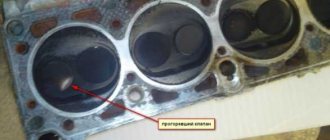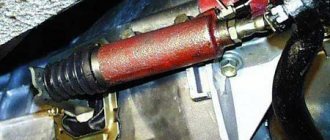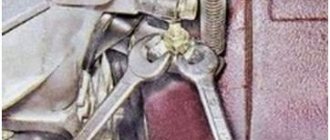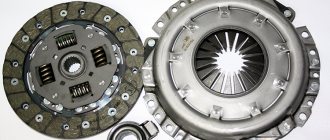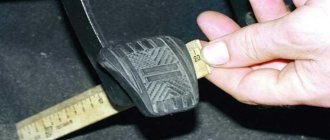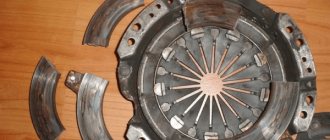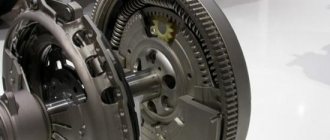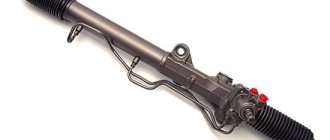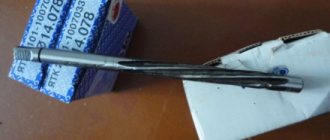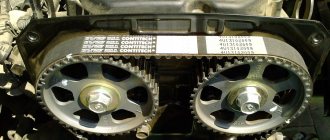Structure and functions of clutch
The mechanical drive of the VAZ 2114, when compared with hydraulics, has a much simpler, but equally durable design. It consists of:
- cable, adjustable in length in the sheath;
Cable location - pedals that control the clutch from the passenger compartment;
- a device that controls the position and free play of the pedal;
- lever structure that transmits force from the pedal to the clutch fork.
The introduction of a cable into the design of the VAZ 2114 made it possible to eliminate complications with hydraulics, for example, very frequent leakage of fluid.
In a VAZ 2114 car, the clutch is a simple unit in design. The system is equipped with a special cable, which, compared to a hydraulic unit, does not require constant maintenance. And you can change this element yourself if necessary.
The drive includes the following parts:
- cable for changing position in a special shell;
- a pedal that the driver controls from inside the car;
- clutch shift fork handle;
- a clamp securing the tip of the cable sheath;
- brake and clutch pedal retainer.
The mechanism is designed to transmit force from the pedal in the car interior to the fork in the engine compartment. This element removes the friction shaft from the flywheel of the power unit. Thanks to the use of cable transmission, AvtoVAZ engineers have ensured that the driver will not encounter problems with oil leakage or the need to remove air pockets from the clutch control system.
In VAZ 2114 cars, the cable is considered the weakest component, so car owners are often faced with the procedure of replacing it. If you correctly install and tighten the cable when adjusting, this will ensure that the driven pulley is pressed well against the flywheel of the machine motor and basket when the clutch is activated.
Clutch device in VAZ 2114
How to replace the clutch cable on a VAZ 2114 without the help of a car service?
Anyone who has already changed the clutch release cable on a Lada 2110 knows that to successfully complete the job, it is not at all necessary to have a special room and a super set of keys. Repairs can be done even outdoors when there is no precipitation. The technology involves the use of:
- Two keys “17”.
- Pliers.
- Grease.
- Ruler for setting.
- Knitted gloves.
You may need to spray WD-40 on areas that have been damaged by corrosion. Litol or graphite lubricant are suitable as grease lubricants.
Dismantling the cable mechanism
As usual, you should first disconnect the negative terminal to prevent a short circuit during the operation. For convenience, it is advisable to remove the air filter. Further actions are performed in the following sequence:
- Using two 17mm wrenches, loosen the nuts securing the cable to the bracket.
- Lift the cable by hand and remove it from the mounting hole.
- Disconnect the cable guide from the clutch fork by hand.
- Clear the area around the clutch pedal from the carpet and remove the locking bracket on the pedal bracket pin using pliers.
- Disconnect the end of the cable drive from the pedal bracket.
- Push the cable into the engine compartment.
- Remove the rubber cushion with the cable from the engine compartment side.
When replacing the clutch cable on a VAZ 2114 car, you should check the condition of the bushing and replace it if necessary.
How to properly adjust the clutch on a VAZ 2114
Modern domestically produced cars have moved away from the classics. Standard clutch adjustment of the VAZ 2114 and other vehicles of the family is performed by tightening the cable rather than by adjusting the hydraulic mechanism, which increases the reliability of the unit.
This mechanism requires periodic adjustment - the steel cable tends to stretch under load, which disrupts the original characteristics.
The drive must be tightened in such cases.
- Violation of the accuracy of gear shifting - squeaks, crackles or other extraneous sounds emanating during manipulations with the gearbox.
- There is a dissonance between the increase in engine speed and the acceleration of the car. This is a clear sign that the clutch disc is slipping under load. A secondary symptom is a burning smell after sudden acceleration or dynamic acceleration.
- The pedal fails or spontaneously rises or falls relative to the reference value.
- The clutch engages early or late, which leads to the car jerking while shifting into gear.
Adjusting the clutch of the VAZ 2114 is one of the most important of the car. It allows you to achieve the most accurate operation of the system, which has a positive effect on the control process and driving comfort of the car. To implement this event, no in-depth knowledge, high qualifications or special professional tools are required.
Clutch VAZ 2115
- Phillips screwdriver or No. 8 head;
- set of open-end wrenches for 13 and 17;
- WD 40 or similar product;
- ruler/construction tape measure/other measuring instrument.
Replacement
a set of serviceable clutch parts for VAZ 2114; sets of spanner and socket wrenches; mandrel; jack.
Let's move on to replacement.
First of all, you need to jack up the car. An inspection hole and overpass are ideal for this purpose.
Remove the front wheels.
Disconnect the ground wire, drive and speedometer cables from the gearbox. It is not necessary to disconnect the cables, but it is worth doing for convenience.
We also disconnect the gear shift drive and the support from the gearbox side.
Use your hands to unscrew the lower casing that protects the flywheel. Inspect the condition of the flywheel. If we notice significant cracks and other defects on its surface, it means it is faulty. Remove (by hand).
Using a size 7 spanner, unscrew the bolts that secure the ball joints. As a rule, there are only 3 of them.
If we are making a complete, rather than selective, replacement, we disconnect the drive shafts from the gearbox and drain the oil. After which you can carefully remove the gearbox.
We unscrew the bolts that secure the gearbox to the cylinders. It is most convenient to use a socket wrench size 8.
Using a size 8 spanner, unscrew the bolts securing the pressure plate to the flywheel.
Remove the pressure and driven discs. The pressure plate is also called the basket. At this stage, you need to make sure that it is working properly. Otherwise, replacement will be required. The working surface should not have cracks or large gaps.
We pry up the ends of the return spring that secures the release bearing.
Remove the clutch, bearing and return spring. We inspect each of the parts in order to understand which ones should be replaced. We twist the bearing in our hand. If you hear a crunching or noise, the bearing is bad, we are preparing a new one for replacement.
Remove the switch plug. We treat the parts with kerosene; if any of the parts are in good condition and do not need to be replaced, we carry out a selective replacement rather than a complete one.
We clean the gearbox input shaft from various dirt and old grease.
We return (or attach a new one) the release bearing, clutch and return spring.
To center the crankshaft, insert a mandrel into its hole. Then we install the driven disk on the mandrel.
We screw it with bolts (with a spanner onto the pressure plate (basket) into the flywheel.
the pressure plate (basket) into the flywheel.
Further installation is carried out in reverse order.
Adjustment
Initially, it is worth measuring the pedal deviation from the norm. To do this, you need to push the drive to the maximum, then release it. It is necessary to measure the stroke length - the distance from the center of the pedal pad in its lower position, when it is resting on the floor, and in its upper position. If the deviation from the normal length is significant, the pedal should be adjusted.
Deviations from the norm can be detected without measurements. To do this, you need to place the car on a flat horizontal surface, engage first gear and, smoothly releasing the drive, start moving. If the car starts moving only at the end of pressing the pedal, debugging is necessary.
In order to adjust the drive of the VAZ 2115, it is necessary to change the length of the cable jacket. To do this, you need to loosen or tighten the two nuts with which it is attached to the bracket.
Open the hood. Remove the air filter. We find the cable and nuts that secure it to the bracket. They are located on its threaded part. Unfortunately, on the VAZ 2115 these parts are located inconveniently. When manipulating the nuts, the length of the cable jacket changes. In order to reduce the stroke, loosen the nut located inside the bracket and tighten the nut outside, and vice versa, if you need to increase it.
If the threads are rusty, you can use liquid to make the threads easier to remove. If there is none, you can use engine oil or brake fluid.
After debugging, you should check changes in the operation of the node. This should be done in the same way as during the initial check for deviation from the norm. After correct adjustment, the stroke does not exceed 135 mm. If the procedure does not lead to anything and the clutch of your VAZ 2115 continues to slip, then the element has become unusable and needs to be replaced.
Watch a video about replacing the clutch on a VAZ 2115 car on our website.
As a vehicle ages, all its main components and mechanisms also wear out. For this reason, it is extremely important to periodically inspect the machine - this will allow you to identify the problem in time and fix it before it leads to a more serious breakdown.
Timely adjustment and inspection of the clutch on the VAZ-2115 will avoid failure of this unit and eliminate the need to replace it. In a car service, as you know, this procedure is not cheap, and it takes a lot of time.
At the same time, an improperly adjusted clutch makes driving uncomfortable for the driver.
In this material we will tell you in detail exactly how to correctly perform this operation and the sequence in which to perform all the necessary actions.
Instructions for adjusting the clutch with your own hands on a VAZ 2114
- Phillips screwdriver or No. 8 head;
- set of open-end wrenches for 13 and 17;
- WD 40 or similar product;
- ruler/construction tape measure/other measuring instrument.
The principle of adjustment is to tighten the cable drive. There are no hydraulics or complex mechanics here - everything is changed and repaired literally “on the knee”. You can see how this is done in the video:
How to adjust the clutch cable
To properly tighten the cable, it is necessary to carry out this procedure.
- Drive the car onto a level surface and put the handbrake on.
- For safety's sake, disconnect the terminals from the battery.
- In the cabin, near the corresponding pedal, place a ruler parallel to its movement. Ideally, the lever pad should be within 13 cm. An error of up to 5 mm is allowed. In case of large deviation, adjustment is required.
- The hood opens.
- There is an air filter near the battery. You can remove it by releasing the air duct clamp (with a screwdriver or a No. 8 socket).
- Under the dismantled can you need to find the clutch cable itself. The part is located near the gearbox housing.
- There is a tensioner lock on it (it looks like several nuts threaded onto the casing and pressing the mounting plate on both sides).
- Use wrench No. 17 to loosen the locknuts. If necessary, you can treat the mount with WD-40 or its equivalent.
- Then, using a 13mm horn, loosen the thrust nuts (1 and 2).
- Next, the tension of the shirt is adjusted. Nuts No. 1, 2 rotate counterclockwise. Thus, the pedal settles closer to the floor; to raise the lever, you need to do the opposite.
- After calibration, the mechanism is assembled in the reverse order.
- Next, you need to press the corresponding pedal 5-6 times all the way and repeat the procedure with the ruler. If there is no position failure, everything is fine.
Adjusting the clutch pedal free play
Adjusting the free play of the clutch pedal correctly is an important measure to prevent wear of the release bearing and unforeseen situations on the road.
The pedal position is set using the same clutch cable. It is considered ideal when the mechanism operates in the middle of the lever stroke. If engagement is observed closer to the floor, it is necessary to tighten the cable.
Note! Every car enthusiast has the right to set the pedal height and the depth of its sag at a level that is not convenient for him. However, the manufacturer recommends this position as a standard.
Correct clutch setting
An important factor in correct tuning is the safe, correct operation of the mechanism. You can check the accuracy of the calibrations in this way.
- Put the car on the handbrake.
- Start the engine in neutral gear.
- Turn on the first one and try to move off without removing the car from the handbrake. If the internal combustion engine jerks and stalls, everything is done correctly. If the movement does not start, but the engine is running, the clutch disc slips, you need to loosen the cable tension.
You also need to drive the car, sequentially engaging all gears. During manipulations, the presence of extraneous sounds, vibrations or dissonance between the set of engine speeds and the acceleration of the machine is strictly unacceptable.
Checking the working stroke of the clutch pedal VAZ 2114
Nuts with which the clutch is adjusted
Having achieved the parameters established by the manufacturer of the VAZ 2114 car, after tightening the lock nut, you need to make sure that you have adjusted the clutch correctly. To do this, you need to press the pedal to the floor 2-3 times and measure its travel again. If there are changes in its progress, the adjustment procedure must be repeated again. Usually the clutch begins to “grab” approximately in the middle of the stroke.
After completing the adjustment, it is necessary to perform one last check:
- park the car on a level area,
- tighten the parking brake lever,
- start the engine and engage the gear,
- Next, you need to try to move, without pressing the clutch.
If everything is set correctly, the VAZ 2114 engine will stall. If the result is different, this means that everything needs to be adjusted again, that is, all the work needs to be done again, according to the instructions.
Loading …
Let's measure the travel of the car's clutch pedal. Before doing this, we move the carpet on the floor of the car back so that the measurements are more accurate.
- Using a tape measure, measure the distance from the floor of the car to the bottom edge of the clutch pedal
- The image shows how best to do this.
- It should be approximately 18-20 cm.
- Press the clutch pedal all the way with your hand and measure the distance from the floor to the bottom edge of the pedal.
- It should be 6-7 cm
- Subtract from 18-20, 6-7, it turns out 13-14 cm
This is the norm for the full travel of the clutch pedal of VAZ 2108, 2109, 21099 cars and their modifications. Many repair manuals indicate a working stroke size of 12.5-13.5 cm, which is also very close to our measurement.
If the clutch pedal travel differs more or less, it is necessary to adjust the clutch drive.
Adjustment procedure
- We wait until the engine cools down a little
, otherwise you may get mild burns. Using the tensioner nut, screw it forward a few turns. The cable will be stretched half a centimeter. For the first time it is quite enough; - We sit down in the salon and, using a ruler, measure two positions: free play and total pedal travel, the indicators should vary within the range of 3.0 – 4.0 cm / 12.5 – 14.0 cm. Having compared the data, we draw conclusions;
- We start the car, smoothly depress the clutch and engage first gear, at the same time feeling the process of inclusion and its completeness. If the gear entered normally, then we try to move forward. We drive a few meters and stop;
- Let’s analyze the main quantity – the distance of the pedal from the floor during the “grip”. Experienced instructors say that it should be 1/3 free, starting from the floor;
- The grip is too low, as well as too high, this is wrong and it will be inconvenient for you to change gears. If the dimensions do not match, then continue to rotate the tensioner nut in one direction or another until the pedal travels within the specified range.
Having adjusted the clutch in place, it is necessary to drive on the highway with all speeds engaged, since it is possible that some may “knock out” or “growl.” If everything is fine, then you can praise yourself for the work successfully done and now you are not afraid of adjusting the clutch on the VAZ 2114.
At the same time, during operations with the nut, carry out a visual diagnosis of the condition of the boot and the outer sheath of the cable. If there is damage, it is better to replace it, otherwise you will be forced to repeat it after a couple of thousand km.
Dust, dirt and water will make themselves felt over time
, which means you’ll waste extra time. In order not to do the same work 100 times, do one, but in a comprehensive manner. Believe me, it is much better and cheaper, first of all for you.
How to determine a breakdown?
First of all, you will need to determine how much the clutch pedal has deviated from the standard values. To take a measurement, you need to do the following:
- the pedal is lowered by hand to the highest possible level;
- then she is released;
- In parallel, you will need to determine the stroke length of the drive using a ruler or tape measure.
First, find out what the distance is from the center point of the pedal to the floor of the cabin in the lowered position, and then take a measurement in the raised position. If it turns out that the deviation from normal permissible values exceeds the maximum, you will need to adjust the clutch.
There is also an option to check without exact measurements. In this situation:
- the machine is installed where there is a completely flat area;
- first gear is engaged;
- The drive is smoothly released, after which forward movement begins.
Debugging will be needed if the vehicle moves only when the pedal has reached the lowest point.
If the pedal squeaks at the very beginning or at the end of its stroke, moves and grips poorly, or even fails completely, this indicates that there are problems in the functioning of the device.
As for the other “symptoms” of a breakdown:
- the driver has difficulty changing gears;
- the traction of the power unit has decreased, especially when driving uphill;
- new sounds appeared, grinding and creaking when pressing the pedal;
- incomplete switching;
- when the driver changes gears, the car slips.
How to adjust the clutch on a VAZ 2108, 2109, 2199
1). When the pedal is released, you need to use a tape measure to measure the distance from the floor to its lower edge. It should be within 18-20 centimeters.
2). Next, press the pedal with your hand all the way to the stop and measure the distance from the floor, again to the bottom edge. It should be within 6-7 centimeters.
3). From the first result obtained, 18-20 cm, we subtract the result of the second measurement, 6-7 cm. As a result, we get 13-14 cm. For cars of the VAZ 2108 and VAZ 2109 brands, this value is considered normal.
4). If this value differs in one direction or another, you will need to readjust the clutch. That is, we either tighten it up or weaken it.
5). We hold the adjusting nut with one wrench, and with the second we slightly loosen the lock nut.
6). By rotating the adjusting nut clockwise, we increase the pedal stroke, and therefore it should move downward.
7). We take measurements and if the result is satisfactory, we tighten the locknut and the work can be considered complete. But if not, then you will need to do this operation again.
Video
How to adjust the clutch on a Lada Kalina?
1). Open the hood and remove the air filter. To do this, unscrew the bolts securing the air filter housing to the hood. Then disconnect the mass air flow sensor. Next, unscrew the clamp and remove the air filter housing.
2). Pull out the cable by the threaded end to the maximum possible distance. In this case, it will be necessary to overcome the resistance exerted by the spring attached to the PS.
3). Holding the cable in this position, using a caliper we measure the distance between the plastic leash and the fork lever. It should be 2.7 cm.
4). If the distance does not match, then using an open-end wrench, we either tighten or loosen the tension nut.
5). Next, we survive the clutch pedal again and take measurements again. If it was not possible to achieve the desired result the first time, you can repeat it again.
6). After the distance has been adjusted, install the air filter in place.
Video
How to adjust the clutch on a VAZ 2107
To adjust the clutch of the VAZ 2107, you need to drive onto a pit or overpass. But in cases where this is not possible, we install the car on supports using a jack, observing all safety measures.
1). The free play must be adjusted so that the distance from the top position of the pedal to the stop is 0.4 - 2 millimeters. Otherwise, you will need to make adjustments. Using a 10mm wrench, unscrew the nut locking the limiter slightly and by rotating it set the required gap.
2). If the VAZ 2107 engine system provides fuel injection, then you will need to remove the protective shield.
3). Before applying the lubricating mixture to the threads of the pusher, clean it from dirt.
4). We check the stroke of the pusher, since the stroke of the release bearing depends on it. Push the fork back all the way, the pusher stroke should be four to five millimeters. Since significant force is required, it is better to disconnect the spring from the lever.
5). The stroke of the pusher is adjusted using a 17 key. It is also necessary to restrain the pusher adjusting nut from turning, but using a “13” wrench, loosen the lock nut.
6). Fixing the pusher using the “8” key, using the “17” key we set the required 4-5 millimeters.
7). We fix the locknut.
 . We check the pedal travel, which should be approximately 30 millimeters from its top position until it turns off. If necessary, you can perform the operation again.
. We check the pedal travel, which should be approximately 30 millimeters from its top position until it turns off. If necessary, you can perform the operation again.
How to change and adjust the cable yourself?
We figured out why the pedal creaks, now let's talk about adjusting the clutch on the VAZ 2114.
When there are problems in the functioning of the system, they must be eliminated. One of the most common problems is a broken cable. Therefore, if the pedal fails, then before properly adjusting and tightening the cable, it must be changed.
If you are experiencing problems with your pedal squeaking, check out the video that demonstrates the procedure for lubricating the device. Filmed by VikiNow.
To adjust the tension and replace the cable, you will need the following devices and tools:
- the cable itself;
- Litol lubricant;
- set of open-end wrenches;
- ruler;
- pliers.
To repair the cable, you need an assistant:
- Open the hood of the car and remove the bolts securing the battery terminals.
- You need to disconnect the connected cable from the pedal itself. Using a 17mm wrench, unscrew the nuts securing the bottom of the product. Then remove it from the retainer and remove it from the plug installed in the engine compartment.
- Further steps are carried out in the car interior. Move the carpet away from the driver's seat. There is carpet under the pedals, it needs to be removed. This will allow you to find the place where the cable is attached to the pedal; the clamp must be disconnected from it. There will be no problems, since this element is simply removed from the hook.
- After which the cable itself is removed from the seat. To do this, the device must be pushed away from you towards the engine compartment. When the product is difficult to push out, most likely its fastening has soured. Then lubricate the retainer with WD-40 and work it out a little, moving it in different directions. If you have an assistant, while you are developing the cable, he can pull it from the side of the engine compartment, this will speed up the procedure.
- After dismantling the product, a new one is installed. Before this, the bushing that secures the cable is removed from the clutch pedal. If its condition is poor, it is worn out, it is advisable to replace the bushing. The retainer itself is lubricated with Litol before installation.
Channel Sdelaj Sam! Pljus interesting! A video has been released showing the procedure for replacing a product with your own hands.
After repairs, the cable is adjusted in height. If you do not adjust the stroke adjustment and adjust it, you will have difficulty changing gears. Before tensioning and adjusting the cable, it is recommended to test drive the machine. It will allow you to figure out how to properly tighten the pedal - raise or lower it.
Position tension diagram:
- If the car begins to move at the end of the pedal stroke, open the hood and locate the cable attachment location. There are two nuts here that can be unscrewed with a 17mm wrench. To reduce the free play of the pedal, that is, lower it, the bolt located inside the bracket is unscrewed. The outer screw must be tightened with a wrench.
- If, when starting to move, you realized that the free play should be increased, that is, raise the pedal, then the inner screw on the metal clamp should be tightened, and the outer one should be loosened. If there is rust on the free play adjustment nuts, it must be removed using WD-40. If there is no fluid, motor oil or brake fluid is used.
- If the adjustment is successful, check the free play with a ruler. If the actions are performed correctly, its length will be from 12.5 to 13.5 cm. This distance will be directly from the pedal itself in the car to the floor.
The VikiNow channel published a video showing the process of changing the cable and further adjusting its free play.
Checking work
If everything was done correctly, then you should make sure that the task was completed correctly. To do this, you need to press the pedal all the way several times, then measure the free play again. After pressing, it may go astray. If this happens, adjust the stroke again. Ideally, the clutch should engage in the middle.
How to check whether all actions were performed correctly:
- The VAZ 2114 car is installed on a flat horizontal surface.
- The handbrake lever is activated.
- The machine engine starts, the shift lever is moved to the first gear position.
- Try to start, but don't press the pedal. When all the setup steps have been completed correctly, the machine’s engine will stall. If the car starts to move, the mechanism needs to be re-adjusted. In this case, all the steps described above are performed again.
The clutch drive adjusting nut is located in the engine compartment of the car on the drive cable sheath, inserted into a special bracket mounted on the gearbox housing. It is protected from unscrewing by a lock nut located there.
Holding the adjusting nut with one 17 mm wrench, use another 17 mm wrench to loosen the lock nut a few turns.
Adjusting the clutch cable VAZ 2114
We rotate the adjusting nut clockwise with one key, holding the locknut with the other - this is to increase the clutch pedal travel (the pedal will rise) or counterclockwise to decrease its travel (the pedal will lower to the floor)
How much to reduce or, conversely, increase the pedal stroke is determined based on the results of the check described above.
Lightly tighten the locknut
Press the clutch pedal several times and check again
If the resulting figure does not fit within the norm, we carry out the adjustment again. And so on until we achieve the required result.
After completing the adjustment, tighten the locknut
How to tighten and adjust the clutch cable of a VAZ-2114: video
The clutch design itself on the VAZ-2114 (Samara-2) car has been changed and differs from what was installed on the “classic” models of the VAZ family. The main changes affected the system of adjustment, control, and movement of the clutch fork. And, if previously they were hydraulic, now its movement is driven by the clutch cable.
Video of clutch adjustment on VAZ-2114
In this article we will look in detail at how to tighten and adjust the clutch cable on a VAZ-2114.
Step-by-step procedure for tensioning the clutch cable on a VAZ-2114
In order to change the length of the clutch cable, we only need a wrench.
1. First of all, open the hood and look for the nuts on the gearbox housing located at the very end of the adjustment unit. Two 17mm bolts.
The clutch cable is marked with a red marker.
2. Next, loosen the locking nut, and then change the position of the adjusting nut, tightening or unscrewing it to the required length.
The nuts will unscrew easily with any pressure.
3. When the nut is screwed on, the clutch pedal will rise, increasing the length of its distance, and if it is unscrewed, the distance to the floor will decrease, pressing the pedal closer to the floor.
The arrow marks the nut for fixing.
4. Upon completion of all adjustment work, the locking nut is tightened as close to the adjusting nut as possible.
When carrying out such procedures, make sure that the clutch cable itself is intact, that there is no damage or scuffing on its body and shell, and that it moves freely inside the elements supporting it. If something like this is discovered, then it is best to replace the cable with a new one, since the wear of the supported one will only increase, and it is impossible to talk about the reliability of the work performed.
Checking work
After you have completed this work, you need to check the correctness of the work performed.
- First, measure the travel of the clutch pedal.
- With the engine turned off, depress the clutch pedal several times and return it to its place.
- Next, we take a new measurement and clarify the received readings.
- If they have not changed compared to the first measurements, then the work has been completed, correctly, and the first stage of verification can be considered completed.
- And if they differ from the first indicators, it means that the locking nut was not tightened tightly, and the adjustment process must be carried out again.
- The car must be placed on a flat surface, the handbrake must be turned on, and the engine must be running.
- Next, we turn on the gear and try to start moving.
- If at this moment, when the clutch pedal is not pressed, the car stalls, this means that the adjustment was made correctly.
- And if this does not happen, the car is running in gear with the clutch pedal not pressed, then this will indicate clutch slipping, which will need adjustment.
The following test can definitively indicate the serviceability and correctly adjusted clutch:
Design
The mechanical drive on the VAZ-2114, despite the fact that it has the least simple design, is in no way inferior in reliability to its hydraulic counterpart.
Its system consists of a cable adjustable in length, sealed in a special anti-corrosion sheath, and the clutch pedal itself located in the car's interior, which, through free movement, is designed to transmit the pressing force to the clutch fork.
Despite the fact that such a scheme is simple, in general it is quite reliable.
Clutch diagram
A new product in the form of a clutch cable for VAZ-2114 cars helped to avoid all the problems that all owners of classics encounter. First of all, this refers to the leakage of hydraulic fluid from the system, and as a result, loss of control over the car. It would also require work to remove air from the clutch system after repair.
Why is it necessary to adjust the cable travel?
This procedure is necessary so that when the pedal, and with it the clutch cable, reaches certain values, the most squat pressing of the flywheel with the basket to the driven disk is made, at the moment when its operation is necessary. At the same time, thanks to the precise adjustment of this drive, the clutch is released at the moment the clutch pedal is released.
You can monitor the condition of the clutch, preventing such a situation from occurring, visually by positioning the clutch pedal relative to the floor of the car, using only a ruler.
Values
The optimal values should be from 125 to 140 mm , when measuring readings first with the pedal pressed and then with the pedal released.
The maximum value that is allowed when measuring such indicators is 160 mm , and if they exceed these values, then this will mean severe wear of the friction linings, and therefore, after adjusting it, the clutch itself may soon need to be replaced.
We measure the result along the bottom edge of the pedal - in the photo the result is normal.
The principle of clutch adjustment
If, after a preliminary check, you have determined that the clutch cable needs adjustment (that is, tightening - approx.), then do not be alarmed, since the process of such work is not complicated and will not require any additional effort.
Clutch cable tension is adjusted by tightening it under the hood
As you might have guessed, if the length of the cable is reduced, then the pedal stroke will be less, the same applies to increasing the stroke, all that remains is to achieve those cherished pedal stroke indicators of 12.5 centimeters.
conclusions
Thanks to these simple steps, adjusting the clutch cable on the VAZ-2114 can be done in the shortest possible time.
When is clutch adjustment required?
Clutch adjustment of the VAZ 2114, and other vehicles, is carried out in cases where defects associated with the operation of this mechanism appear. Such malfunctions include:
- clutch pedal adjustment;
- clutch cable adjustment;
- pedal height adjustment;
- clutch adjustment.
In another case, the need to adjust the clutch drive may arise due to previous incorrect adjustment. It is possible to reduce or increase the working stroke of its pedal.
The photo shows the clutch of a VAZ 2114
As a result, malfunctions occur in the operation of the drive - the clutch begins to “slip” or “drive”, gear shifting becomes difficult, jerks appear when starting from a standstill, fuel consumption increases, etc.

